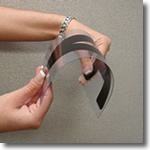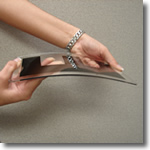Understanding the Differences Between
Flexible and Rigid Sign Letters for Portable Signs

Flex Change Letter (Flexible Sign Letter)

Rigid Sign Letter (Gemini or Wagner Zip Change)
Introduction
For businesses, schools, churches, and any organization that utilizes portable signs, choosing the correct type of sign letter is crucial for functionality and longevity. Two main types of sign letters dominate the market: flexible sign letters and rigid sign letters. Each type has its specific characteristics, track requirements, and uses. This guide will explore the differences between flexible and rigid sign letters, the importance of compatible track systems, and offer tips to help customers identify the type of sign letters they need.
Whether you're looking to replace worn-out letters or setting up a new sign, this guide will provide the information you need to make an informed choice.
Overview of Flexible Sign Letters
Flexible sign letters, often referred to as "Flex Letters," are made from pliable plastic materials that enable them to bend and conform to specific track systems. Commonly made from pliable materials such as plastic, flexible sign letters offer several advantages and are designed to bend to place in their track. Here are the key characteristics and benefits of flexible sign letters:
-
Bendable Material
Flexible sign letters are crafted from materials that allow them to bend slightly, making it easy for the letters to fit into the tracks. This feature is beneficial for businesses that change their signage messages frequently, such as restaurants with daily specials, gas stations, and retail stores.
-
Track Compatibility
Flexible letters require a track system that can hold them securely by allowing them to slide or bend into place. This track system typically uses a groove or channel that accommodates the slight flexibility of the letters, holding them firmly once they’re inserted. It's essential for customers to know that flexible sign letters are incompatible with rigid letter tracks, as rigid tracks lack the necessary flexibility to hold these letters in place.
-
Ease of Installation
Due to their bendable nature, flexible sign letters are easy to install and remove. This makes them a popular choice for locations where the message changes regularly. However, flexible letters may not have the same durability as rigid letters, especially in high-wind or extreme weather conditions.
-
Cost-Effectiveness
Flexible sign letters are often a cost-effective choice, especially for businesses that need to change messages frequently and may wear out letters faster due to frequent handling.
Overview of Rigid Sign Letters
Rigid sign letters, in contrast, are made from hard, non-bendable materials like acrylic or polycarbonate. These letters offer a more sturdy, professional look. Unlike flexible letters, rigid letters do not bend and are designed for tracks that require at top and bottom (or middle section) that use the push-up-and-drop-down motion.
Here’s a breakdown of the main attributes of rigid sign letters:
-
Sturdy Construction
Rigid sign letters are made from materials that do not bend, giving them a more durable, professional appearance. Their rigid structure also makes them better suited to withstand challenging weather conditions, such as high winds or extreme heat, as they are less likely to warp or distort over time.
-
Track System Requirements
Rigid sign letters require a unique track system that allows the letters to be pushed up from the bottom and then dropped into place. This track design differs significantly from the flexible sign letter track, as it accommodates the stiff nature of rigid letters and holds them securely without the need for bending.
-
Ease of Use for Permanent Messages
While rigid letters can be changed, they are often preferred for signs with semi-permanent messages, such as store hours, names, or simple phrases that don’t need regular updates. Their durability means they’re likely to last longer, even with occasional rearrangement.
-
Higher Initial Investment
Rigid sign letters may come with a higher initial cost due to the quality of materials used, but their durability often makes them a worthwhile investment for businesses needing long-lasting signage.
Key Differences Between Flexible and Rigid Sign Letters
Understanding the differences between flexible and rigid sign letters can help customers select the right type for their needs. Here’s a quick comparison:
| Feature | Flexible Sign Letters | Rigid Sign Letters |
|---|
| Material |
Flexible plastic |
Rigid acrylic or polycarbonate |
| Track Type |
Requires bendable tracks |
Requires push-up/drop-in rigid tracks |
| Installation |
Easily bent to fit track |
Push up and drop down into place |
| Durability |
Moderate (may wear out faster) |
High (resistant to weather and wear) |
| Best for |
Frequently changing messages |
Semi-permanent messages |
| Cost |
Generally more affordable |
Higher initial investment |
Why Track Compatibility Matters
A major difference between flexible and rigid sign letters is the type of track required. Flexible sign letters need a track that can accommodate their bendable material, while rigid sign letters need a track that allows them to be pushed up and dropped down. This incompatibility means that using the wrong type of letters will not function in the other type. Flexible letters won’t stay in place in a rigid track, and rigid letters don’t fit in a flexible track. For a secure, reliable display, it’s essential to use the correct letters with their corresponding track type.
Customers should ensure that they know the track type of their sign before ordering new letters. For those unsure, reaching out to a sign supplier like SignOutfitters.com, can help clarify which type of letters will work best for their existing sign system.
How to Identify Your Sign Letters
If you’re unsure of which type of sign letters you have, check how the letters fit into the track. Flexible letters will bend as they are inserted, while rigid letters require a more mechanical push-up and drop-in motion. Additionally, examining the track for flexibility or rigidity can offer clues about the compatible letter type.
Conclusion: Making an Informed Decision
Choosing the correct sign letters is essential for maintaining effective, readable signage. By understanding the key differences between flexible and rigid sign letters, as well as their respective track requirements, customers can ensure a seamless and professional look for their portable signs.
For assistance with selecting the right type of letters or upgrading your existing sign system, SignOutfitters.com, offers a range of options and expert advice. Properly matched letters and tracks lead to longer-lasting signs, increased readability, and ultimately, a more polished presentation for any business.
Click here for PDF version.